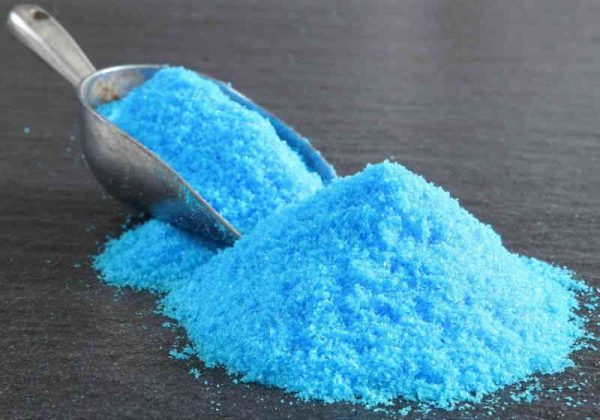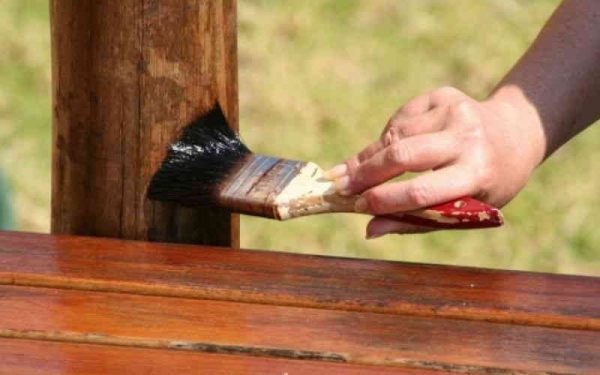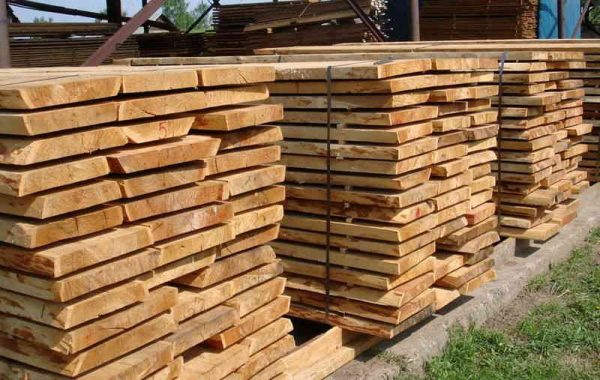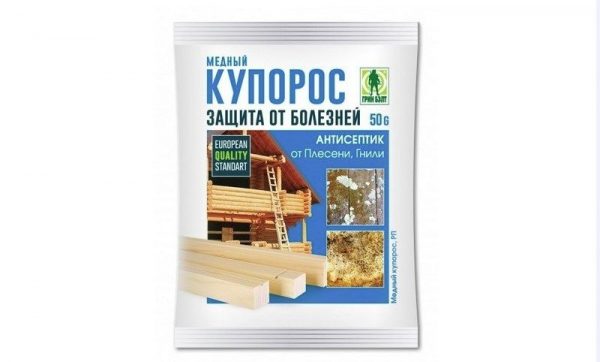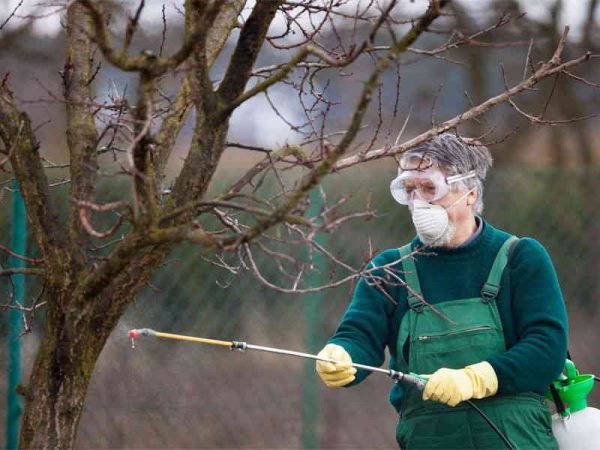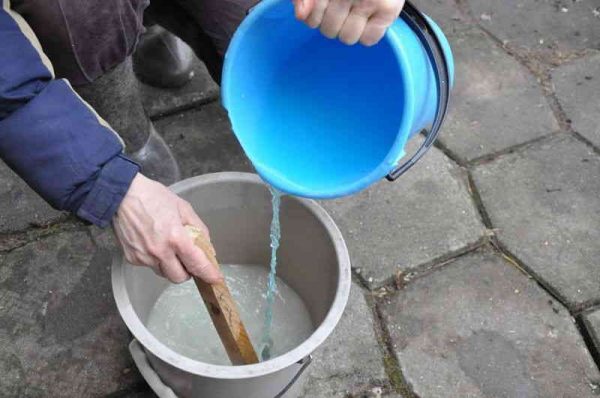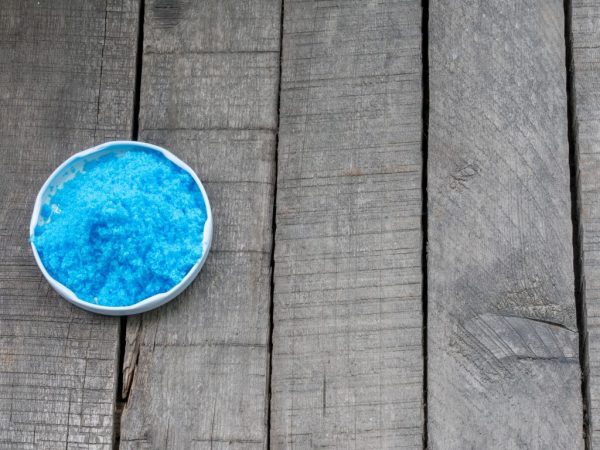Natural wood is the oldest building material that has a natural origin, environmentally friendly and durable. But despite its durability, the tree is often spoiled by insects, molds, various microbes. Without protection, the material may darken and begin to rot.
- Why coat wood with copper sulfate
- Types of wood processing with vitriol
- Surface application
- Mortar Treatment
- Internal impregnation
- Industrial processing
- Precautionary measures
- Garden application
- Use of vitriol as fertilizer
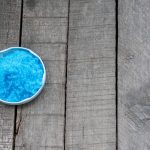
Wood sulphate wood processing is a reliable way to improve the performance of freshly cut wood, lumber or finished buildings.
Why coat wood with copper sulfate
Wood fibers resemble a sponge: they can absorb a large amount of moisture from the air or in direct contact with a liquid. Juice is preserved in the sawn tree, and if dried poorly, it can rot.
Without additional processing, lumber can deteriorate in a short time, while ordinary varnishes and paints only clog the moisture inside, preventing it from evaporating. Applying copper sulfate, a well-known antiseptic, to wood is much more effective.
Copper sulfate, or copper sulfate - a salt of sulfuric acid, a bluish powder, odorless. For humans and warm-blooded animals, the toxicity of this substance is moderate, but for bacteria and many insects it is highly toxic. The tool has the following properties:
- astringents;
- antiseptic;
- disinfectants.
If you process the tree with vitriol, it will begin to struggle with the existing problems and will be an excellent preventive measure against woodworms, mold microbes, bacteria, fungi. The substance does not change the natural shade of the tree, but it stops the developing rot. Due to the relative harmlessness, incombustibility, non-volatility, vitriol can be used in homes and cattle pens.
Also, the advantages of the tool include its cheapness and availability in stores - it is sold everywhere. The substance also has a minus: it spoils the metal, therefore it is not suitable for wood into which nails are already driven, screws are screwed in or other metal elements are present.
to contents ↑
Types of wood processing with vitriol
Copper sulfate can be used in different ways, each method has its own characteristics and differences in the conduct.
Surface application
This method is the least time-consuming, it can be implemented quickly, but the surface protection period will be short. Typically, the application of copper sulfate by this method is practiced with existing rot, fungal infection of the material. If the wood is fresh or poorly dried, the substance will be washed out of the base even faster.
The procedure is as follows:
- take 10 g sifted through a small sieve of vitriol, dilute in a liter of water;
- moisten a brush or sponge, rags in the solution;
- apply the diluted product to the base;
- a sprayer can also be used for work: a solution is poured into it and a wooden surface is irrigated.
to contents ↑With this treatment, only a layer of wood no more than 2 mm thick is protected. If deep cracks appear in the material, fungi or insects can settle in them.
Mortar Treatment
Usually, wooden poles are protected in this way, which are then to be buried in the ground. For boards used in construction, the method is inconvenient, since the consumption of copper sulfate will be large, and it is not always possible to find a convenient container. A 20% solution is prepared, the columns are immersed in it (completely or only in that part that will be in the ground), left for 2 days. Then the columns are dried in a natural way for about a month under a canopy, placing the processed end down.
to contents ↑Internal impregnation
A different method can be used for processing recently sawn wood. Copper sulfate, when it is performed, will be mixed with wood juice that has not yet come out, which will allow it to penetrate into deeper layers of the material. Since the sap flow continues for several days, the impregnation should be carried out as soon as possible.
The process must be carried out as follows:
- put a tree on the ground;
- make a transverse incision (in half, but not completely);
- insert a wedge into the gap that appears to increase the distance between the halves of the tree;
- install a lead tube there, which goes into the container with a 15–20% copper sulfate solution with the other end (the container should be at a height);
- if possible, cover the gap with tar or tow so that the antiseptic does not flow to the ground;
- leave the fixture for 3-5 days, then dry the tree.
to contents ↑
Industrial processing
In industry, special methods are used, involving the use of professional equipment. The tree is dried, loaded into a large autoclave, poured with a solution of vitriol. At a temperature of about +40 degrees, the pressure is increased to 10 atmospheres, as a result of which the substance penetrates into the deeper layers of the material. After a half-hour treatment, the wood is taken out and dried. At home, the use of such a technique is almost impossible.
to contents ↑Precautionary measures
Despite the small danger, copper sulfate is a chemical substance, and if it comes in direct contact with skin, mucous membranes, and ingestion, it can be harmful to humans. After acting with it, you need to rinse your mouth, wash your face and hands. Work with the product in gloves, protective clothing. If the solution is applied indoors, use a respirator.
With the penetration of the composition into the body, signs of poisoning appear:
- nausea, vomiting;
- itchy skin, allergy manifestations;
- pain in the digestive tract;
- weakness;
- arrhythmia.
With the development of these symptoms, seek medical help immediately!
to contents ↑Garden application
Copper sulfate is familiar to every gardener - it is an inexpensive and effective antiseptic that destroys pests. The trees are usually sprayed in early spring, when the buds just begin to swell, and also in the fall, when the leaves are already fallen. In summer, irrigation of trees with a solution is rarely done, because it can burn greens. 20-30 g of chemical substance is taken per liter of water.
Other ways of processing trees:
- To destroy pests in the trunks. Take 10 liters of water, dilute 400 g of lime, 300 g of copper sulfate. Spray the trunks or apply a solution to them with a brush.
- To treat a rotten tree or get rid of moss, lichen. Dilute 100 g of vitriol in a liter of water, irrigate the affected areas.
- For the treatment of spotted necrosis, grape diseases.Prepare a 5% solution of vitriol, spray the plants (it is advisable to work in the fall).
Use of vitriol as fertilizer
This chemical contains copper, which is a valuable trace element for plants. Its lack is manifested by yellowing of leaves, loss of brightness by flowers, falling of young shoots. It is necessary to dissolve 5-10 g of vitriol in a bucket of water, after which use a foliar fertilizer for tomatoes, cabbage, potatoes.
Copper sulfate is a cheap but very useful fertilizer, high-quality antiseptic. It can be used without fear, but subject to technology, proportions and protective measures - then the result will be excellent.

